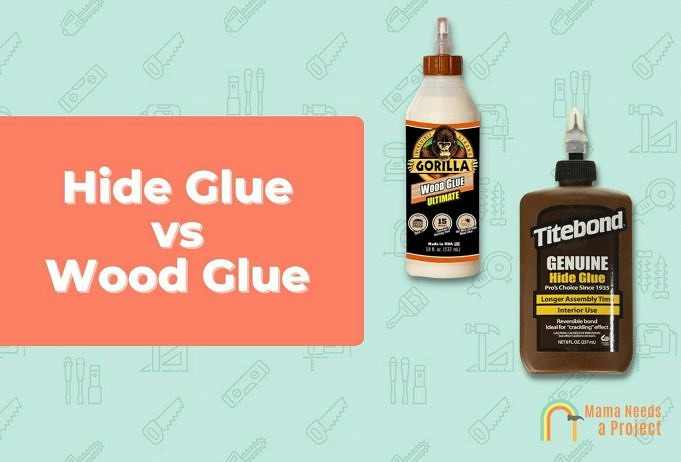Wood glue isnt exactly a new invention.
Actually, glue and adhesives were used to complete woodworking projects since antiquity. Although the idea is not new, technology has changed. In modern times, there are actually a number of different adhesives that are designed and best used for specific projects and purposes.
We are going to share some of the top woodworking glues for DIY projects.
What Is Hide Glue?
Maybe youve heard the old joke about a horse breaking his leg and getting sent to the glue factory. That horse would have been made into hide glue, which is a protein-based glue often made from various animal tissues that were boiled.
Gross, right?
For certain projects, hide glue can still be used. For instance, many who restore/rebuild pianos will use hide glue.
Hide glue has one drawback: it is water-soluble. This means that things attached to hide glue may lose their connection when exposed to the elements or in high humidity.
On the plus side, hide glue takes a very long time to cure so it can be helpful for projects that take a while to complete because you can reposition the piece (if needed) for quite a while.
Best Hide Glue For Woodworking
The Behlen Ground Hide Glue is a great choice for hammer veneering. This hide glue is a true hide glue. It will not affect the finish if you need it.
Some finishes may not be compatible with other types of glue, such as bone glue.
This will likely be mixed.
White Glue Vs. Yellow Glue
Some woodworking glues are often referred to simply as white glue or yellow glue.
What is the difference?
They are both polyvinyl acetate adhesives. However, their purposes are often different.
White glue is more of an all-purpose glue, used on porous materials. White glue is great for crafting and small indoor projects. It bonds by water evaporation, which means it can be wiped up with water making it simple to clean and generally safe to use around pets and children.
White glue usually cures within 5-20 minutes.
Yellow glue is generally formulated to be used only on indoor projects and isnt moisture resistant.In fact, neither white or yellow glue is ideal if you absolutely need a water-resistant bond.
For example, you wouldnt want to work on an exterior door or assemble outdoor furniture with common white or yellow glue.
Yellow glue can cure faster than white glue and can also be sanded much more easily. Yellow glue is therefore the go-to choice for many woodworkers who are hobbyists.
It is important to be able to quickly clean it up if you use it. You can wipe it off with water, but only while its still wet. Yellow glue can dry yellow and show through your stain and finish.
Best All-Around Woodworking Glue
Titebonds Original Wood Glue is the perfect choice if you want to have the best of both.
It prides itself by offering the fast set and handling ease of white glues and tack-toughness-durability of hide glue.
This is something we can’t argue with. You’ll find that people of all levels will endorse this product.
Elmers is another one of the big names in glue, but in this case there is no comparison. Although they may appear similar, Titebond is stronger than Elmers when it comes to bond strength.
Best Glue For Outdoor Projects
As mentioned, one of the limitations of most yellow and white glues are that they dont do well when exposed to the elements like rain and humidity.
When working on outdoor furniture projects, consider a polyurethane glue.
Considering how long hide glue has been around, polyurethane glue is kind of like the Justin Bieber on the glue scene very young and new. It debuted in the US within the last 20 years, and has made quite a splash.
The water and moisture in the air causes polyurethane glue to cure. A quick spray of water before applying glue will improve the bond. The color of polyurethane glue is a light amber to tan and can be stained, painted, and sanded. You can clean it with mineral spirits, but you must scrape or sand the surface. When working with polyurethane glue, gloves are essential. Once dry, it can be difficult to remove.
Mark Singer, founder of Gorilla Glue, stated that shear strength is not the strongest feature of polyurethane glues, but the stuff is amazing in end grain to end grain. It far outperforms (yellow glues) in end grain. If you coat both surfaces with polyurethane glue, Ive seen it (the glue) migrate 5 cm into wood.
So for water resistance and affixing wood to different materials (painted wood to non-painted) polyurethane is an excellent choice.
Our top pick?
The original Gorilla Glue.
Here are the key points as to why we think Gorilla Glue is best in class:
- Versatility. It works well with wood, but it can also bond to stone, metal, ceramics, foam, concrete, and so on.
- Waterproof.Its completely waterproof for outdoor applications, but isnt super messy and hard to work with like epoxy.
- Climate neutral.If your location is in Canada or Miami Gorilla Glue works well in both hot/cold temperatures.
What About Epoxy Adhesive?
Epoxy adhesive is the real deal, and its pretty serious stuff to work with. If you’re working with epoxy, this guide will help you.
For the hobbyist and weekend woodworker, I dont know that epoxy is completely necessary because its a bit of a hassle to work with.
For instance, you need gloves, good ventilation and should really wear a respirator when using it. This glue can be messy, even if it is not as messy as the others.
It is completely waterproof, which is a big benefit. However, for most jobs you should be able to use something like Gorilla Glue and be just fine.



